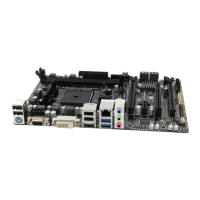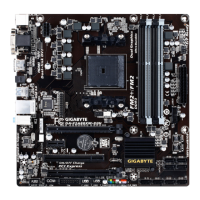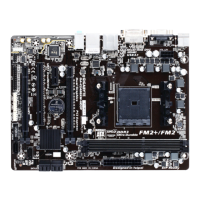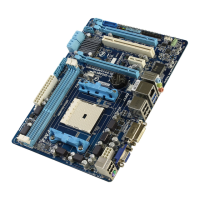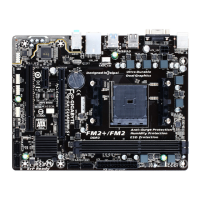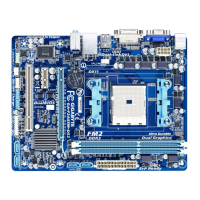- 19 -
1-6 SetupoftheAMDDualGraphicsConguration
Combining the onboard GPU with a discrete graphics card, AMD's Dual Graphics technology can provide
signicantly advanced display performance for AMD platform. Read the following instructions on conguring a
Dual Graphics system.
A. System Requirements
- AMD A series processor
- Windows 8/7 operating system
- An AMD Dual Graphics technology-supported motherboard (with the BIOS updated to the latest version)
and correct driver (make sure the onboard graphics driver version is Rev. 8.982 or above)
- An AMD Radeon
™
HD 6000 series graphics card that supports AMD Dual Graphics technology (for more
details, please visit AMD's ofcial website) and correct driver
B.InstallingtheGraphicsCardsandConguringBIOSSetup
Step 1:
Observe the steps in "1-5 Installing an Expansion Card" and install an AMD Dual Graphics technology-supported
graphics card on the PCIEX16 slot. Plug the monitor cable into the graphics card and start up your computer.
Step 2:
Enter BIOS Setup to set the following items under the Peripherals\GFX Conguration menu:
- Set Integrated Graphics to Force.
- Set UMA Frame Buffer Size to 512M or above.
Save the settings and exit BIOS Setup. Restart your computer.
C.ConguringtheGraphicsCardDriver
After installing the graphics card driver in the operating system, go to the
AMDVISIONEngineControlCenter. Browse to Performance\AMD
Radeon
™
Dual Graphics and ensure the Enable AMD Radeon Dual
Graphics check box is selected.
(Note) Make sure the drivers for the Chipset, onboard graphics, and external graphics card are properly
installed.
Procedure and driver screen for enabling the AMD Dual Graphics technology may differ by graphics
card and driver version. Refer to the manual that came with your graphics card for more information.

